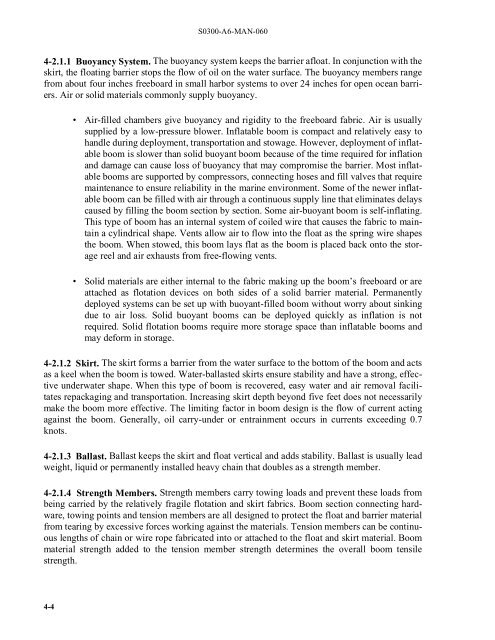U.S. Navy Ship Salvage Manual Volume 6 - Oil Spill Response
U.S. Navy Ship Salvage Manual Volume 6 - Oil Spill Response
U.S. Navy Ship Salvage Manual Volume 6 - Oil Spill Response
- No tags were found...
Create successful ePaper yourself
Turn your PDF publications into a flip-book with our unique Google optimized e-Paper software.
S0300-A6-MAN-0604-2.1.1 Buoyancy System. The buoyancy system keeps the barrier afloat. In conjunction with theskirt, the floating barrier stops the flow of oil on the water surface. The buoyancy members rangefrom about four inches freeboard in small harbor systems to over 24 inches for open ocean barriers.Air or solid materials commonly supply buoyancy.• Air-filled chambers give buoyancy and rigidity to the freeboard fabric. Air is usuallysupplied by a low-pressure blower. Inflatable boom is compact and relatively easy tohandle during deployment, transportation and stowage. However, deployment of inflatableboom is slower than solid buoyant boom because of the time required for inflationand damage can cause loss of buoyancy that may compromise the barrier. Most inflatablebooms are supported by compressors, connecting hoses and fill valves that requiremaintenance to ensure reliability in the marine environment. Some of the newer inflatableboom can be filled with air through a continuous supply line that eliminates delayscaused by filling the boom section by section. Some air-buoyant boom is self-inflating.This type of boom has an internal system of coiled wire that causes the fabric to maintaina cylindrical shape. Vents allow air to flow into the float as the spring wire shapesthe boom. When stowed, this boom lays flat as the boom is placed back onto the storagereel and air exhausts from free-flowing vents.• Solid materials are either internal to the fabric making up the boom’s freeboard or areattached as flotation devices on both sides of a solid barrier material. Permanentlydeployed systems can be set up with buoyant-filled boom without worry about sinkingdue to air loss. Solid buoyant booms can be deployed quickly as inflation is notrequired. Solid flotation booms require more storage space than inflatable booms andmay deform in storage.4-2.1.2 Skirt. The skirt forms a barrier from the water surface to the bottom of the boom and actsas a keel when the boom is towed. Water-ballasted skirts ensure stability and have a strong, effectiveunderwater shape. When this type of boom is recovered, easy water and air removal facilitatesrepackaging and transportation. Increasing skirt depth beyond five feet does not necessarilymake the boom more effective. The limiting factor in boom design is the flow of current actingagainst the boom. Generally, oil carry-under or entrainment occurs in currents exceeding 0.7knots.4-2.1.3 Ballast. Ballast keeps the skirt and float vertical and adds stability. Ballast is usually leadweight, liquid or permanently installed heavy chain that doubles as a strength member.4-2.1.4 Strength Members. Strength members carry towing loads and prevent these loads frombeing carried by the relatively fragile flotation and skirt fabrics. Boom section connecting hardware,towing points and tension members are all designed to protect the float and barrier materialfrom tearing by excessive forces working against the materials. Tension members can be continuouslengths of chain or wire rope fabricated into or attached to the float and skirt material. Boommaterial strength added to the tension member strength determines the overall boom tensilestrength.4-4
















